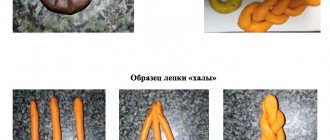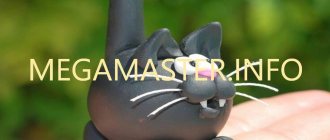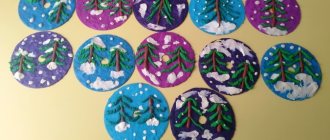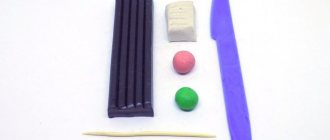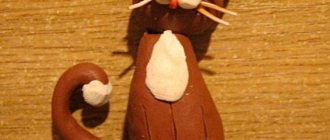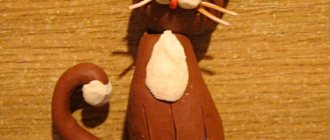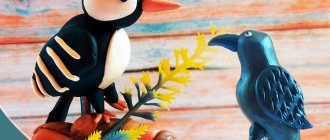Working with plasticine is always a great pleasure for kids. This is not just a game, but also the development of a child’s love for animals. Kids learn to be in harmony with nature and also train their fingers. Bunnies are fluffy, soft little animals that almost everyone loves. I would like to have a figurine of him at home made from various materials. How to make a hare from plasticine will be interesting to learn for both kids and their parents.
- Step-by-step instructions on how to make a hare craft from plasticine
- Video master classes on how to make a hare from plasticine
- How to work correctly
- Techniques for making different plasticine bunnies
- Application for children of the younger group and beginners
- Simple three-dimensional hare crafts
- Bunny figurines combined with other materials
- Detailed figurines of hares made of plasticine
Step-by-step instructions on how to make a hare craft from plasticine
To work, you need to stock up on material in gray, white, blue and pink. The sequence of actions is as follows:
- You need to start working from the hare's head. Pinch off a piece of gray color and roll it into a neat, smooth ball.
- Then the body is made from the same color material. You need to sculpt an oval part of the required size.
- Connect the torso and head.
- Make the fluff that hares have on their chests. Make a triangle out of white and attach it to the chest of the craft with the base to the head. Use a toothpick to make grooves on it to make it look like fur.
- The hare's paws will be the same size and shaped like an elongated drop. Attach them to the body, bend the front ones slightly towards the stomach.
- We make a bunny's face from plasticine. For the cheeks, roll two identical white balls, flatten them slightly and glue them side by side on the face. For the nose, take pink, make a ball, flatten it and place it between the cheeks.
- For the eyes, take white, make flat circles and glue on the muzzle. Place flat, slightly smaller blue circles on top of them, and even smaller black circles on them.
- How to make ears for a hare from plasticine? Make a flat piece in the form of an elongated drop from gray material. Make the same thing out of white mass and glue it on top of the gray one. Make two pieces and attach them to the hare's head so that they hang.
The plasticine hare is ready, all the kids will like it.
Video master classes on how to make a hare from plasticine
Make Krosh the bunny from Smeshariki:
DIY plasticine bunny for children 4-5 years old:
Plasticine hare for children, educational video:
Summary of GCD for modeling in the middle group “Grey Bunny”
Notes on modeling "Grey Bunny" in the middle group. Synopsis of GCD for modeling “Grey Bunny” in the middle group. “Health” contributes to the development of an increasingly sustainable interest in the rules of health-preserving and safe behavior, and the development of children’s independence. OO "Physical Culture" continue to form correct posture. OO "Socialization" to develop the ability to participate in collective games and activities, establishing positive relationships based on compliance with basic norms and rules of behavior (not to interfere with each other, if necessary, help, take into account the interests and desires of partners, etc.). NGO "Poznanie" develops children's research activities using simple visual schemes. OO “Artistic Creativity”, in the process of sculpting, consolidate the techniques that the children learned in the previous group; connecting parts by pressing and smearing them (head to body, etc.); arouse interest in decorating sculpted products using stacks. Handouts: plasticine, modeling board, stacks, pink and blue bows, buckwheat eyes, pea nose, fine noodle mustache, yellow, green, blue, red rugs. Demonstration material: soft toy hare, algorithm for performing a bunny Methodological techniques: game situation “a hare came to visit us”, interactive technology “Big Circle” conversation about the hare (body parts, details, encouraging children to take action - “let’s make friends for the hare”, independent activity of children, physical exercise “the little white bunny is sitting...”, visual activity of children, summing up. SOT: health-saving, gender approach, interactive technology. Progress: Children stand around the carpet. Educator: Game situation - Guys, he came to visit us today extraordinary guest. Guess who it is? Loves red carrots, Gnaws cabbage very deftly, He jumps here and there, Through forests and fields, Gray, white and oblique, Who do you think he is? Children: - Bunny. Educator: - Look how wonderful he is. Guys, pay attention to his body parts. What body parts does a hare have? Children: - Torso, head, legs, paws, ears, tail. Educator: - Tell me, what shape is the torso? Head? Legs? Paws? Ears? Tail? Children answer: oval, round. Educator: - Which part of the body is the largest? Children: - Torso. After the body, in size comes the head, then the legs, paws, ears and the smallest part - the tail. Considering the algorithm with children Let's play the game “Big Circle” (interactive technology). Children stand in a circle, passing the bunny, saying what it is. Children: - Agile, fast, long-eared, cowardly, short-tailed. Educator: - Guys, look, our guest came to us alone. Let's make him some friends so he won't be lonely. The teacher offers to go to the board, where the algorithm for performing the bunny is laid out, and they sort out the diagram of where to start. — Guys, tell me how to sculpt the body? Head? Paws? Ears? Tail? Children (with the help of a teacher) - You need to take a stack, break off a piece of plasticine, roll it out with circular movements of your palms to form a ball, then roll out the plasticine into an oval shape with straight movements. - You need to do the head like this: roll out the plasticine in a circular motion into the shape of a ball. — Paws and ears are made by rolling out “sausages.” - For the tail, take the smallest piece of plasticine and roll out a small ball. Educator: - Pay attention. First, the head is attached to the body, then the legs, paws, the ears are attached to the head, then the tail. Each part must be tightly lubricated when connecting. Children sit at tables, the teacher pays attention to the children’s posture. Educator: -But before making a bunny, let’s do finger gymnastics. Deftly from finger to finger. The bunny jumps, the bunny jumps. It rolled down, turned around, and came back again. Again, from finger to finger, the bunny is jumping, the bunny is jumping! Educator: - The bunny will watch, and you will. Let's get down to business. Take a stack and break off a piece of plasticine using the stack. Which body part should you start with? Children: - From the body. (The teacher describes the sculpting process out loud). Educator: - Now let's continue. Which part will you sculpt? Children: - Head. (The teacher describes the sculpting process out loud). Educator: - Let's continue. Which part will you sculpt now? Children: - Paws and legs. (Children sculpt). Educator: - Which part will you take on now? Children: - Ears. (One child describes the sculpting process out loud). Educator: - Well done, everyone can do it. And what's left to create? Children: - Tail. (The teacher, together with the children, describes the sculpting process). Offer the children blue and pink bows; each child must choose whether he made a boy or a girl. The girl (bunny) has a pink bow on her head, the boy (bunny) has a blue bow on her neck. Educator: - You are probably a little tired. Stand near your chairs and follow the movements and words after me. The little white bunny sits and wiggles his ears. Like this, like this, He moves his ears. It’s cold for the bunny to sit, We need to warm our little paws, Like this, like this, We need to warm our little paws. It's cold for the bunny to stand, the bunny needs to jump. Like this, like this, the bunny needs to jump. Reflection. -Did you enjoy sculpting bunnies for your little bunny today? -What good deed did you and I do today? The teacher takes a soft toy: “Our guest really liked the friends you made.” Well done! Now place the bunnies in the clearing.
How to work correctly
Children really enjoy working with this material. In addition, modeling teaches you to work with both hands at the same time, trains fine motor skills and creative imagination. To make a craft from plasticine, you need to learn the rules for sculpting small elements and working with different types of the material in question.
There are different types of plasticine: regular, wax, granular, fluorescent, with glitter. For kindergarten children, it is better to use the fluorescent variety, it is softer than usual. To make the material soft, it must be placed in a warm place or held in your hands.
There are the following techniques for working with this mass:
- rolling out;
- rolling;
- flattening;
- topping;
- pulling;
- smoothing out.
Having mastered them, you can create various figures.
There are basic shapes: a ball, a “cake” and a roller. You need to start working by cutting the block or pinching it off. After separating a piece of mass, you can begin to make various details of the craft. The ball needs to be rolled in a circular motion with your palms or done on a board. A “cake” should be made from a ball, squeezing it between your palms. It is necessary to connect the elements immediately, before the material has hardened, pressing down the parts and pressing them lightly.
To ensure that the small elements of the figurine are the same in size, you should cut even blanks from the new block. You need to roll up a roller from the already used material and then cut it into equal parts.
Techniques for making different plasticine bunnies
A plasticine bunny can be molded using various techniques. Children in different age groups of kindergarten sculpt bunnies from different types of material. Therefore, it is important to consider several techniques on how to sculpt a hare from plasticine.
Application for children of the younger group and beginners
For a plasticine hare figurine, which is sculpted by children from the younger group, you need to prepare a sheet of brown cardboard and plastic material: white and blue.
Step-by-step modeling of a hare from plasticine for children is presented as follows:
- First you need to make snow by mixing both colors together and, after kneading them thoroughly, apply them to the bottom of the cardboard, filling a certain space.
- From a white block you need to sculpt the parts of a bunny: head, torso, legs and tail. Apply them to the base, pressing lightly with your finger and palm.
- Use black plasticine or beads to make eyes and a nose for the bunny.
- Apply white pieces to a piece of cardboard to imitate snowflakes.
A simple application is ready. You can give it to a friend or decorate your room.
Simple three-dimensional hare crafts
We sculpt a hare from plasticine with the children of the middle group of kindergarten in different versions.
The white plasticine hare is made of two parts. First you need to sculpt the body from a thick oval-shaped piece. Then bend the upper part a little, and form paws on the lower part: press the dents on four sides with your fingers. Make an oval for the head, then draw out a nose from it.
Pull out the second part more strongly and use a stack (with a small knife, on the other side there may be a spatula) to divide it into two parts, these will be the ears. Make a hollow between the ears with a round pencil, and do the same with the outer parts of the ears. Make the inner surface of the ears and mouth from the pink mass. From black - eyes, glue them on the muzzle. Connect the torso and head. Roll a small white ball and place it in place of the tail.
This hare can be molded from light plasticine. There are few details in his figure; they are made quickly, without having time to dry. This bunny is made of airy plasticine and has practically no small parts that dry quickly, making it difficult to glue them together.
Bunny figurines combined with other materials
Crafts made from plasticine and other available materials are considered more complex. Children from 1st grade can cope with them, but with the help of their parents. The most popular materials at hand are paper, cardboard, tree leaves, spruce or pine cones.
Easter bunny made of plasticine on the lawn: a plasticine figurine is located on a green lawn made of cardboard and paper. In the photo - this is a pink version of a hare with Easter cake and Easter eggs:
A hare made of plasticine and a pine cone. The craft is very beautiful and interesting. It can be given to friends or loved ones. This is an excellent material to use and is easy to work with.
Detailed figurines of hares made of plasticine
Complex crafts are made from a large number of parts or from a more serious material, which is sculptural plasticine.
You can make a hare from sculptural plasticine in a simpler way in this way:
- First you need to make three blanks: the head, the torso and the lower part. Immediately give them the desired shape and connect them together using coating. You will get a general shape from which you need to form and sculpt the remaining elements of the animal.
- Make the front legs from flagella, attaching them to the body and giving them the desired position.
- The hind legs are made from thicker strands and attached to the lower part of the body.
- Make the ears from oval blanks and give them the desired position: they stand or hang, it’s up to the “sculptor”.
- Make the tail out of plasticine in the form of a ball and place it in place.
Using a sharp tool, detail the muzzle and chest, identifying the eyes and mouth, folds and fur on the chest.
Hare from the cartoon “Well, wait a minute!” This is a very popular craft in the older group of kindergarten. Both adults and children love him. How to make a hare, the diagram and sequence of actions is presented in the video.
You can sculpt a bunny figurine in different ways, using different tones of plastic material, using different methods. Plasticine crafts are distinguished by their diversity, originality and creative implementation.
Summary of a modeling lesson on the topic: “Bunny - long ears”
Program content:
1. Teach children to sculpt a hare from plasticine, conveying the characteristic features: the body is ovoid, the head is a modified ball, the legs are cylinders, the tail is a ball, the ears are flattened cylinders. Use color as desired. 2. Teach children in a combined way. Use the following techniques: roll out the plasticine with circular movements of your hands until you get a ball; roll out the ball with straight hand movements until you get an ovoid; roll out the plasticine with straight movements of your palms until you get cylinders; draw eyes in a stack; Carefully smooth out the joints. 3. Explain the execution of your actions: back and forth, straight movements, cultivate accuracy in work. 4. To instill in children a desire to sculpt, to finish what they have started, and to cultivate accuracy in their work.
Previous work
: modeling cylinders from plasticine with direct hand movements; balls with circular movements of the hands; ovoids, rolling out the balls with straight movements of the hands.
Individual work
: teaches Masha.S., Vanya.F.
do the work independently, without the help of a teacher. Material for the teacher:
bunny - toy, hares - option. Samples from plasticine of different colors; plasticine, board; napkin; stack
Materials for children: plasticine in a set, board /individual/, napkins, stacks.
Progress of the lesson.
The children are sitting at the table. I am reading poetry. Once upon a time there was a bunny with long ears. The bunny's nose froze at the edge of the forest. My nose froze, my tail froze, and I came to warm up and visit the kids. I carry a bunny toy. - Guys, look, a bunny has come to us. -What color is the bunny? What body parts does the hare have? (torso, head, ears, tail, paws). What does the head look like? What about the torso? What shape are the ears and paws? That's right, guys. Do you know why the bunny came to us? He got bored in the forest, he wants to find new bunnie friends. Well, guys, let's help him? Then today we will sculpt bunnies from plasticine. Look how I will do it. I have balls of different sizes prepared in advance: a large ball for the body, a medium one for the head and a small one for the tail. I also made cylinders for the paws and ears. I take a large ball and roll it with straight forward and backward movements of my arms until I get an ovoid. This is the torso. Now I take the middle ball and pull out the muzzle. And now I press the head to the body and smooth it at the junction. Then I take two cylinders and press them to the body - these are the paws, and I also smooth it. And now I take the stack and draw the eyes. So I got a bunny. Guys, where do we start? (Roll out the balls). Show how we roll out the ball (with circular movements of the palms). What about the cylinders? (straight arm movements back and forth). Now, children, take some plasticine and start working. I draw the children's attention to the variable patterns, to the fact that they are of different colors. I remind you how to roll out an ovoid. I distribute cardboard carrots to the children (carrots with the children’s names). -Guys, bring your bunnies to our guest and place them around him. Let him look at your work. Bunny is very happy to make new friends and thanks you. Well done children, everyone did their best. And now the bunny wants to play with you.
Game "Grey Bunny Washes His Face."
